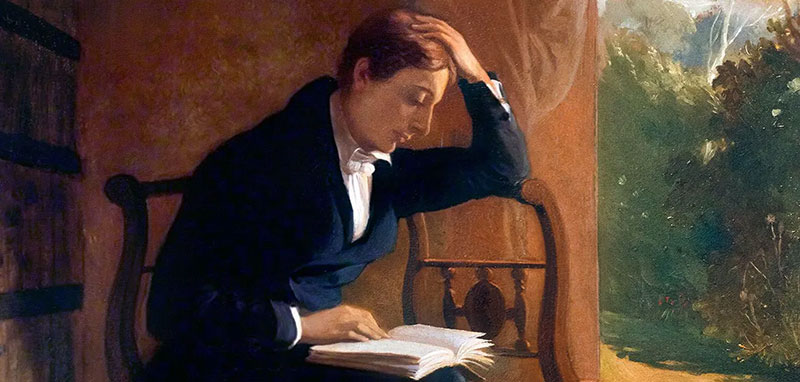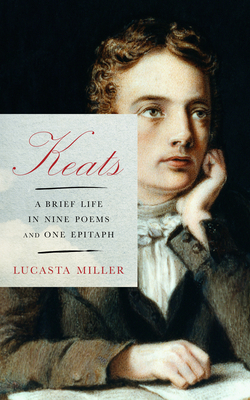
by Mike Dillon
Modern readers do not need to be told to admire John Keats: whether they know it or not, he has already entered their dreams, he is a portion of their hopes, he lives in their desires.
—Stanley Kunitz, “The Modernity of Keats”
Orphaned at fourteen and dead of consumption in 1821 at twenty-five, John Keats was the son of a London stablemaster who lived his life as an existential errand. Had Shakespeare died at the same age, the Bard might be remembered for a few light comedies, and the works of Chaucer would not exist at all. But Keats is not only still with us; in some ways his work is more modern than ever. In one of his many matchless letters, his modernity shines through in a mere seven words: “That which is creative must create itself.”
And so, the books about John Keats keep coming, delivering fresh angles of approach. Lucasta Miller’s Keats: A Brief Life in Nine Poems and One Epitaph (Knopf, $32), is an intimate, informed journey of discovery — “a book by a reader for readers,” she writes. Miller, author of The Bronte Myth and L.E.L., examines nine poems and the famous epitaph inscribed on Keats’s tombstone in Rome—“Here lies one whose name was writ in water”—as entry points for exploring the circumstances of Keats’s life.
Miller writes with incisive, poetic succinctness. She finds Keats’s last, great poem, “To Autumn,” is marked by its “loamy Anglo-Saxon vocabulary,” and notes critic Helen Vendler’s treatment of Keats’s development of the sonnet form as “brilliantly exploring its workings like some sibylline car mechanic.”
“On First Looking into Chapman’s Homer,” Keats’s “breakthrough poem,” as Miller calls it, starts things off. What was it about George Chapman’s 1611 translation of Homer that triggered one of the great tone poems in the English language? According to Keats’s friend Charles Cowden Clark, who read the Chapman translation one evening alongside Keats, a passage from Book Five of the Odyssey stood out:
His cheeks and nostrils flowing, voice and breath
Spent to all use, and down he sank to death.
The sea had soak’d his heart through . . .
Miller compares that last line, with its Shakespearean grit, to the period’s popular yet enervating translation of Homer by Alexander Pope: “And lost in lassitude lay all the man.”
It’s difficult, from our postmodern perspective, to see through Keats’s sometimes archaic diction and grasp the young poet’s quest to “make it new,” as Ezra Pound would urge poets to do a century later. But, as Miller points out, Pope-admirer Lord Byron, after reading “Ode to a Nightingale,” famously complained to Leigh Hunt that he did not understand what “a beaker full of the warm south” meant. This, from the most famous poet in Europe.
When Miller contrasts the richness of “The Eve of St. Agnes” with the spareness of “La Belle Dame sans Merci,” written a few months later, we enter speculative terrain: “Its protagonist is a medieval ‘knight-at-arms’ who has loved and lost a supernatural femme fatale; she feeds him, tells him she loves him, and lulls him maternally to sleep, only to abandon him to an eternity of anemic loneliness on a cold hillside.”
It’s risky to apply biographical underpinnings to a work of art, but this feels right. As does Miller’s insight on Keats’s letters: “Their very fluidity reflects the society in flux to which he belonged, in which issues of taste, authority and literary register were up for grabs.” She goes on to show how the Enlightenment, which put humans rather than God at the center of consciousness, incubated “the development of the private realm as a site of emotional and aesthetic value.” Miller’s book is shot through with terrific moments like these.
In another new tome, Bright Star, Green Light: The Beautiful Works and Damned Lives of John Keats and F. Scott Fitzgerald (Yale University Press, $30), Jonathan Bate delivers a masterful exploration of affinities. Bate is the author of more than a dozen highly regarded books, including biographies of Shakespeare, Wordsworth, John Clare, and Ted Hughes; here he weaves two literary lives modeled on Plutarch’s Lives of notable Greek and Roman personages.
Bate acknowledges Fitzgerald’s affinity for Keats is well known, but that “the full extent of the influence, its pervasiveness across Fitzgerald’s career, the sense that he saw himself as the prose Keats, remains underappreciated.” With a sympathetic and sharp eye, he clearly aims to correct that, excavating the subterranean veins of gold flowing from Keats to Fitzgerald. Both were filled with unattainable longing. Both died thinking they’d fallen short of the mark. For Fitzgerald, Keats’s “Bright Star” became Jay Gatsby’s light at the end of Daisy’s dock.
Three novels—This Side of Paradise, The Beautiful and Damned, and The Great Gatsby—were published between 1920 and 1925, before Fitzgerald’s twenty-eighth birthday. Tender is the Night, published in 1934, with its title taken from a line in “Ode to a Nightingale,” represented a brave act of resistance during the author’s downward slope. While H.L. Mencken saluted The Great Gatsby for the “charm and beauty of the writing,” Bate observes, “That beauty would not have been possible without Keats,” and backs up his statement with a dive into “The Eve of St. Agnes,” which Fitzgerald believed exhibited “the richest, most sensuous imagery in English, not excepting Shakespeare.”
Near the book’s end, Bate recounts a story about Fitzgerald walking along Hollywood Boulevard with his paramour, Sheila Graham, in 1940, the last year of his life. With years of alcohol abuse in his past, along with tuberculosis and a legendarily tempestuous marriage to Zelda Sayer, the literary boy wonder of the Jazz Age had found refuge in Hollywood as a scriptwriter. The pair came across a shop sign: “Make your own records—hear yourself speak.” They stepped inside and paid their money.
We can hear Fitzgerald’s recitation of Keats’s “Ode to a Nightingale” online; there are a few miscues in diction, and Fitzgerald trails off before the poem is finished. But to hear Fitzgerald recite Keats’s haunting masterpiece is to hear a great American writer, steeped in his own mortality, do deep justice to a young English poet dead for almost 120 years. Bate writes: “Go, now, listen.”
Shakespeare’s influence on Keats is well chronicled. Bate has done the same for Keats and Fitzgerald. Thanks to Lucasta Miller and Jonathan Bate, we glimpse how a community of writers and readers carries on through the ages.
Click here to purchase Keats at your local independent bookstore:
Click here to purchase Bright Star, Green Light at your local independent bookstore:
Rain Taxi Online Edition Fall 2022 | © Rain Taxi, Inc. 2022



